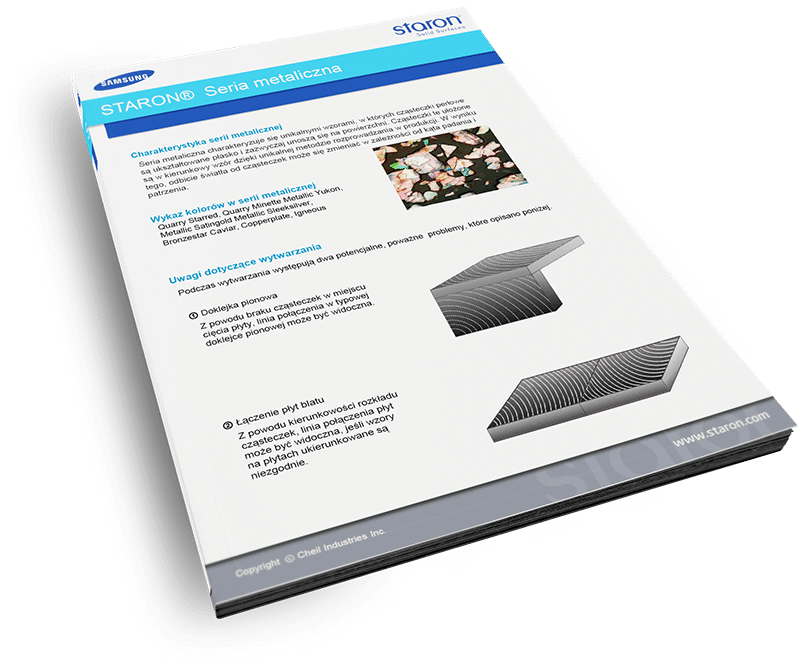PROCESSING AND ASSEMBLY
NOTE: When buying and before processing, make sure that the boards from which the product will be made come from one production batch. Due to variable material properties and production process parameters individual parts of the material may slightly differ in the shade of colors. These minor differences in color are not material defects and therefore cannot be claimed. This should be considered in the planning and management of the project implementation before applying appropriate design solutions.
GENERAL INFORMATION
STARON® material can be processed with carbide tipped cutting tools and woodworking machines.
The most important machining steps are:
- cutting
- milling
- drilling
- bonding
- moulding
- grinding
PROCESSING MINERAL AND ACRYLIC BOARDS.
MIRKA technology
Surface finish: matt
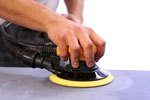 |
1. Surface grindingGrind the surface evenly with the Abranet abrasive in the following graining order: P120> P180> P320> P500 |
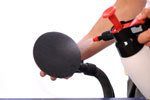 |
2. Surface finishingFinish the surface with Abralon grit 360. |
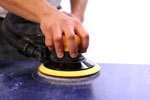 |
|
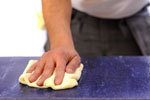 |
3. Surface controlWipe the surface clean with a microfiber cloth. |
Surface finish: satin
 |
1. Surface grindingGrind the surface evenly with the Abranet abrasive in the following graining order: P120> P180> P320> P500 |
 |
2. Surface finishingFinish the surface with Abralon grit 360. Wet the disc with water !!! |
 |
|
 |
3. Surface controlWipe the surface clean with a microfiber cloth. |
Surface finish: gloss
BONDING
STARON® sheets can be glued together with STARON® methyl methacrylate adhesive. This glue is matched to the color of the sheets. After removing the residual glue from the gluing process and after the final surface finish, the joints are practically invisible.
EXPANSION
Characteristic coefficient of thermal expansion of the material of 30.5 × 10-6 [1 / K] (corresponding to 1 mm per meter with a temperature difference ΔT of 30 ° C) must be considered for all material applications.
MOULDING
STARON® sheets have thermoplastic properties and can be shaped into three-dimensional elements. The possible bend radius depends on the thickness and color of the material.
| Solid / Sanded | Sheet thickness: 6mm | Bending radius: approx. 25mm |
| Solid / Sanded | Sheet thickness: 12,3mm | Bending radius: approx. 76mm |
| Aspen / Pebble | Sheet thickness: 12,3mm | Bending radius: approx. 127mm |
| Quarry / Metallic | Sheet thickness: 12,3mm | Bending radius: approx. 203mm |
Comments:
Deformations can appear during:
a) vacuum processes
b) pressing processes
Tempest sheets can only be shaped to a limited extent.
For special installations, we recommend performing deformation tests.
TECHNOLOGY OF MAKING PRESSED PARTS
Staron® material processing enables the creative creation of a wide variety of stamping parts, which are manufactured using three basic processes:
MOLDING
STARON® pressed parts meeting the requirements of international markets are cast in closed molds by Samsung in its plants.
DEEP PRESSING PROCESS
STARON® sheets are thermoplastic and can be shaped in three dimensions. The deep drawing technique enables the production of simple molds as long as the material constraints are met. These products are made in the processes of pressing or vacuum pressing.
JOINING PROCESS
In the case of joining, it is possible to glue together elements made with different techniques, which allows the creation of elements of more complex shapes.
INTERNAL RAYS AND GRAINING
From a hygiene point of view, the best transition between horizontal and vertical planes in STARON® installations is the semicircular transition. They are obtained by gluing two sheets with STARON® glue and finally milling the arch (radius R = 12,5 mm). Appropriate tools also enable circular joints to be made in internal corners.
INSETS
Thanks to the use of inserts and gluing techniques, STARON® offers two basic options for designing elements using inserts.
Glued insets
In this case, elements made of STARON® material are joined with each other using STARON® glue after prior milling (numerically controlled machine tool) of appropriate shapes. The color structures of the sheets remain intact and complement each other.
Cast insets
Milled voids (on numerically controlled machine tools) are filled with STARON® glue of the appropriate color, and then, after the glue has cured, flat ground. These inserts can have uniform colors, have a continuous structure and can be color-matched to customer requirements.
BACKLIGHTING
Special STARON® sheets (i.e. Dazzling White sheets) are translucent to light and enable the creation of innovative objects with light effects. Design options are additionally enhanced by pattern milling techniques (local material thickness reduction) and color inserts.
The places where the sheets are joined and the glued joints cause shadows when illuminated, so they should be avoided or properly included in the design. You should also pay attention to the available dimensions of STARON® sheets. Use only cold light sources for backlighting.
BOLTED JOINTS
Never fasten the boards directly or with self-tapping screws.
Screw connections are made using plastic dowels inserted into the holes made.
Alternatives:
Joining boards by using penetrating bolts or dowels.
THERMAL PROTECTION
When installing cooktops in table tops made of STARON® sheets, pay attention to the following:
- Shaping internal corners with a decreasing radius.
- Reinforcement of internal corners and cutouts with sheet metal elements from the STARON® Plattenelementen range.
- Masking the edges of STARON® sheets with heat-insulating tape
Compared to other materials from which kitchen worktops are made, surfaces made of STARON® are characterized by excellent thermal resistance. Nevertheless, it is possible to damage the plates made of this material in the case of direct placing on them of hot pans, dishes or some devices that emit heat, such as: electric grills or fryers / fryers. To protect the surface of the worktop, always use heat-resistant mats or pads with rubber feet. STARON® surfaces should be protected against extremely high temperatures.
The above information for designers is only an excerpt from the recommendations for processing STARON®. They only contain information of an auxiliary nature in the detailed design development process.











